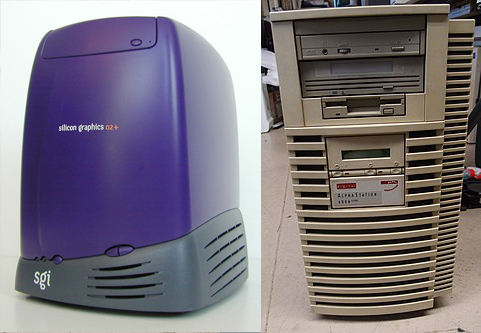
My experience with 3d art and animation began with the release of the Commodore Amiga series of computers in the late 1980’s. I scored an Amiga A500 and began experimenting with programs such as VistaPro (a fractal terrain generator) and Aegis Animator (basic polygonal modeler, animator, and painting). My last Amiga was a 25MHz 2500UX with a Bridgeboard and Emplant Mac emulator, and was capable of running AmigaDOS, MSDOS, Unix, and MacOS pretty much simultaneously. True computer multitasking was officially a thing.
By the early- mid 1990’s, high-end 3d was limited to the realm of Silicon Graphics Workstations running Power Animator (the grandfather of what would later be Autodesk Maya) and SoftImage. A MIPS-processor-based SGI Iris Indigo ran north of $40,000 with Power Animator an additional $15K.
Little did I know that by 1996 I was going to be sitting at a desk using an SGI 02+ running Power Animator and DEC Alpha 64-bit PC running Lightwave. This was the age of workstations.

My embedded QA work within Black Isle Studios on Fallout 2 provided an opportunity to work as a 3d Artist on Planescape: Torment. Fortunately for me, they were using Lightwave 5.0. I would spend the next 10 years in game development, working across the country creating 3d art and animation for clients across several industries.
After making some games I created and ran a small architectural visualization department (complete with my very own render farm!) within a civil engineering firm. From there I decided to share some of that experience working in a pilot program at John’s Hopkins University, where I worked as a Lead Instructor of Advanced Animation and Game Design. Post that I started contracting in the Serious Games Industry, which I have done in one capacity or another for quite some time now.
Much of my time has been as a CG generalist, with the vast majority of my time as a contractor contributing work to games, visualizations, and demos. Along the way I picked up a lot of software experience covering standard graphics production (Lightwave, 3dsmax, Maya, Blender, Adobe Creative Suite), game engines (Infinity, Lithtech, Renderware, Unity, Unreal, and others), reality capture and 3d recording (Autodesk Revit, Leica Cyclone, Faro Scene, and Agisoft Metashape), global information systems (ArcGIS, QGIS) and drafting (AutoCAD) specialty software (Gaea for terrains, RealFlow, Keyshot) and more plugins than I can remember. I never really got into print or web, all of my experience is in 3d. Along the way I’ve accumulated over a decade’s worth of experience in management roles.